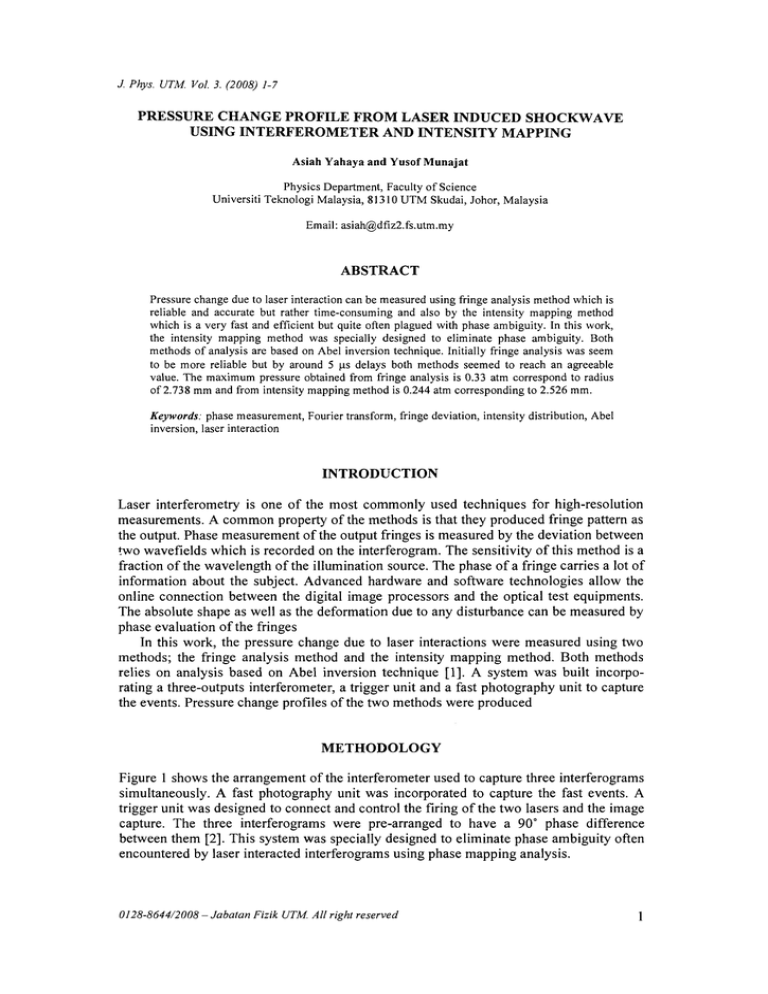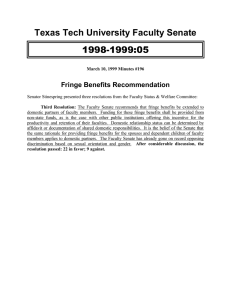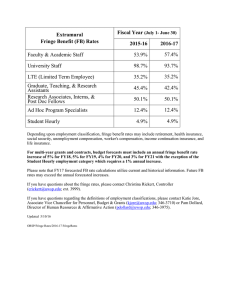PR ESSU RE CH ANGE PROFILE FROM LASER... USING INTERFERO M ETER AND INTENSITY M APPING
advertisement

J. Phys. UTM. Vol. 3. (2 0 0 8 ) 1-7
PRESSURE CHANGE PROFILE FROM LASER INDUCED SHOCKW AVE
USING INTERFEROM ETER AND INTENSITY M APPING
Asiah Yahaya and Yusof Munajat
Physics Department, Faculty o f Science
Universiti Teknologi Malaysia, 81310 UTM Skudai, Johor, Malaysia
Email: asiah@dfiz2.fs.utm.my
ABSTRACT
Pressure change due to laser interaction can be measured using fringe analysis method which is
reliable and accurate but rather time-consuming and also by the intensity mapping method
which is a very fast and efficient but quite often plagued with phase ambiguity. In this work,
the intensity mapping method was specially designed to eliminate phase ambiguity. Both
methods o f analysis are based on Abel inversion technique. Initially fringe analysis was seem
to be more reliable but by around 5 (is delays both methods seemed to reach an agreeable
value. The maximum pressure obtained from fringe analysis is 0.33 atm correspond to radius
o f 2.738 mm and from intensity mapping method is 0.244 atm corresponding to 2.526 mm.
Keywords: phase measurement, Fourier transform, fringe deviation, intensity distribution, Abel
inversion, laser interaction
INTRODUCTION
Laser interferometry is one of the most commonly used techniques for high-resolution
measurements. A common property of the methods is that they produced fringe pattern as
the output. Phase measurement of the output fringes is measured by the deviation between
two waveflelds which is recorded on the interferogram. The sensitivity of this method is a
fraction of the wavelength of the illumination source. The phase o f a fringe carries a lot of
information about the subject. Advanced hardware and software technologies allow the
online connection between the digital image processors and the optical test equipments.
The absolute shape as well as the deformation due to any disturbance can be measured by
phase evaluation o f the fringes
In this work, the pressure change due to laser interactions were measured using two
methods; the fringe analysis method and the intensity mapping method. Both methods
relies on analysis based on Abel inversion technique [1], A system was built incorpo­
rating a three-outputs interferometer, a trigger unit and a fast photography unit to capture
the events. Pressure change profiles of the two methods were produced
M ETHODOLOGY
Figure 1 shows the arrangement of the interferometer used to capture three interferograms
simultaneously. A fast photography unit was incorporated to capture the fast events. A
trigger unit was designed to connect and control the firing o f the two lasers and the image
capture. The three interferograms were pre-arranged to have a 90° phase difference
between them [2]. This system was specially designed to eliminate phase ambiguity often
encountered by laser interacted interferograms using phase mapping analysis.
0 1 2 8 -8 6 4 4 /2 0 0 8 - J a b a t a n F izik UTM. A ll righ t re se rv e d
1
J. Phys. UTM. Vol. 3. (2 0 0 8 ) 1-7
m
DYE
-X
M,
YAG
sample'-
W4
BS3
BS2
m2 V
Ai
CCD1
■ f r
compensator
A3
BS4 ^ ------ (— CCD3
A2
CCD2
Figure 1: The M ach Zehnder interferometer
Figure 2 shows an example of the interferogram of laser interaction which was
captured by the monochrome CCD camera. It was captured 3.6 (xs after the initial trigger
of the Nd:YAG laser. The interference fringes were produced by the Nitro-dye laser. The
fringe deviation from the initial straight and parallel fringes is due to Nd:YAG
interaction. The deviation of the fringes indicates the change in the phase as the refractive
index of the media changes due to laser interaction.
The relation between the fringe deviation AF, and the refractive index, n, can be
written as [3]:
A F (x,y)=
\{ n { x ,y ,z ) - n x }dz
(2.1)
■'i
where F(x,y) is the undisturbed fringe separation.
Figure 2: The interferogram
If the sample has a uniform thickness L with a refractive index o f n(x,y) which does
not vary in the z direction, the relationship can be further simplified to:
0 1 2 8 -8 6 4 4 /2 0 0 8 - J a b a ta n F izik UTM. A ll righ t re se rv e d
2
J. Phys. UTM. Vol. 3. (2 0 0 8 ) 1-7
A n{x,y)=
AF(
L
(2.2)
\
where A f(x ,y ) = — -—
is called the fringe shift. Thus the refractive index is proF \x ,y )
portional to the fringe shift. The theoretical relationship between the refractive index n of
a medium and its density p is described by the so-called Clausius-Mossotti equation
n 2 -1
nz +2
= K 'p
(2.3)
The constant K ’ is dependent on the molecular properties of the material and the
frequency of the incident radiation. In liquids and gases where the refractivity, n- 1 is
small, the relationship between the refractive index and its density p can be simplified
further to give the well-known Gladstone-Dale relation;
n - \ = Kp
(2.4)
where K = 3K ’/2. The change in the refractive index An can also be expressed as the
change in its density, Ap;
An = KAp
(2.5)
The above relationship is accurate for pressures up to approximately 100 bars [4],
Usually, it is more convenient to express the changes in the density of a sample, as the
changes in its pressure. Since the pressure, usually generated in the laboratory is less than
100 bars, a constant of proportionality between two variables pressure, P and density, p is
assumed. Thus, a modified Galdstone-Dale relationship becomes;
An = CAP
(2.6)
where the constant C = — and the unit is bar'1, and c is the speed of sound. From here, it
c
is clear that the change in the refractive index is proportional to the change in pressure of
the medium.
ANALYSIS
Fringe Analysis
The deviation of the fringes at the center of the interferogram is due to change in phase as
the acoustic wave propagated after interaction with Nd:YAG laser. Due to the
symmetrical nature of the wave propagation (disturbance), the image can be divided into
several concentric zones which then again be divided into several chordal divisions
(Figure 3). Fringe deviations were made from the selected reference. The best reference
would be a line running through the center of a dark fringe from the undisturbed region of
the image, which runs through the center of the image. Fringe deviations AFs were
0 1 2 8 -8 6 4 4 /2 0 0 8 - J a b a ta n F izik UTM. A ll righ t re se rv e d
3
J. Phys. UTM. Vol. 3. (2 0 0 8 ) 1-7
measured from this reference at certain intervals (chordal divisions). Global Lab software
was used in the determination of the fringe deviations. Fringe deviations were measured
in the chosen half section as the other half is a mirror image of it. Calibration factor was
previously determined from the magnification factor of the image.
From the calibration factor which was set for this interferogram, the radius o f the
disturbance shown in Figure 2 was found to be 3.245 mm. The chosen section was divid­
ed into 31 chordal zones and thus each zone was represented by three pixels. Increasing
the number of chordal zones would smoothen the fringe shift profile thereby increasing
the accuracy. The data collected using Global Lab software was fed into a computer
program which was written using Mathcad 7, for the fringe shift and pressure change
calculation. Figure 4 shows the pressure change profile of half o f the interferogram
through its center. The other was assumed to be a mirror image of that. The maximum
pressure change recorded with this analysis was 0.33 atm, which occur at a radius of
2.738 mm. Measurements were made using laser energy of 3.7 mJ at room temperature of
25°.
Figure 3: Chordal devisions and fringe deviations
E
.5
<D
W)
ec3
o
<D
s—
CL,
Radius in mm
Figure 4: Pressure change profile using fringe trekking m ethod
0 1 2 8 -8 6 4 4 /2 0 0 8 - J a b a ta n F izik UTM. A ll righ t re se rv e d
4
J Phys. UTM. Vol. 3. (2 0 0 8 ) 1-7
Intensity M apping
A three-step algorithm with phase step of 90° and a phase offset of 45° was suggested [5],
[6]. The simplified intensity equations of the three simultaneously-captured
interferograms
(3.1)
The measured intensity distribution (I (.x,yj) of each of the three interferograms is
then Fourier transformed to give a fitting linear combinations of the harmonic spatial
functions [7]. Only one o f the two spectral sidelobes in this frequency domain is
necessary to calculate the phase. The admissable spatial frequencies of the harmonic
functions are defined via the cutoff frequencies of the bandpass filter in this domain. By
means of digital filtering, the sidelobe is filtered to remove the unwanted noise before
undergoing the inverse Fourier transform to get back the a much cleaner signal in its
spatial domain. The resulting phase S(x,y) for a three-frame technique for a n/2 phase
shift as in Equation (3.1) is given by [8].
(3.2)
S(x, y) = arctan —---- '
1 ,-1 -
The phase change can be translated to change in refractive index and pressure change
using Equations (2.1) to (2.6). The pressure change of a half of the disturbance associated
with laser interaction 3.6 (Js after triggering is as shown in Figure 5. The maximum
change is pressure recorded using this method is 0.244 atm which occurred at a wave
radius o f 2.526 mm. Measurements were made at laser energy o f 3.7 mJ at room
temperature. The profile indicated in Figure 5, represents the same change at the same
instant as that produced in Figure 4. Thus, the maximum pressure change obtained using
this method was found to be lower than the fringe analysis method by 26%.
E
cd
0.5
C
0.2 44
0
c
C3
oUrn - 0 . 5
3
-1
0
4
Radius in mm
Figure 5: Pressure change profile with intensity m apping m ethod
0 1 2 8 -8 6 4 4 /2 0 0 8 ~ J a b a ta n F izik UTM. A ll rig h t r e s e r v e d
5
J. Phys. UTM. Vol. 3. (2 0 0 8 ) 1-7
The reduction of the value of the maximum pressure change compared with fringe
analysis could be due to the filtered nature of the images being analyzed using intensity
mapping method. With simultaneous phase mapping, the images were digitally filtered to
remove the unwanted noise, before analyses were made. During this process, part of the
signal could have been removed.
Measurements were then made at other time delays to produce a profile relating the
findings from the two methods.
DISCUSSION
Plotting the results obtained from the two methods of analysis summarized the con­
clusions of the research. Figure 6 shows the plot of the maximum pressure change due to
laser interaction at different time delays using the two methods.
From the profiles produced, it actually shows the rapid decrease in the pressure
change coming from the shock wave region toward the acoustic wave region. Actually,
images could be captured at a much earlier time than the 2.0 (is, the starting point for
calculation in the graph shown in Figure 6. However, as the waves at this stage were
unsymmetrical, due to laser focusing, calculations were made only after the wave took up
a more spherical shape.
At the beginning, fringe analysis seemed to be more reliable since it was much easier
to determine fringe-centers of smaller size fringes. As the waves propagated, the sizes of
the fringes in the interaction region also expanded. This meant that, there were now more
pixels to represent a fringe, and thus, simultaneous analysis would be gaining accuracy
over fringe analysis. By around 5 |lxs delays both methods seemed to reach an agreeable
stage as indicated by about the same values of the pressure change produced.
Unfortunately, after that time, the disturbances produced were larger than the selected
size of 256 x 256 pixels chosen for this analysis and therefore further analysis cannot be
carried out. However, with the knowledge that sensitivity and accuracy of the
simultaneous phase mapping method relies on the number of pixels representing a fringe,
we can be sure that this methods would have an advantage over fringe analysis as the
waves propagated further.
0.6
-
\ x \$
0)
0.4 -
♦ simultaneous analysis
'• 1 :
Q_
0.2
■ fringe analysis
-
2
3
4
time (us)
Figure 6: M axim um change in pressure w ith tim e
0 1 2 8 -8 6 4 4 /2 0 0 8 —J a b a ta n F izik UTM. A ll rig h t r e s e r v e d
6
J. Phys. UTM. Vol. 3. (20 0 8 ) 1-7
The average values for both methods were presented in Figure 6 with 5% error bars.
The slight deviation from the expected smooth profile could be due to the fluctuation of
the laser energy burst producing the interactions.
CONCLUSION
With this understanding, it did not seem fair to make comparisons to the two values,
especially at shorter time delays. However from the profiles obtained, both indicated
rapid reduction on the maximum pressure change soon after laser interaction, which,
gradually reduced to a more agreeable change by the two methods.
REFERENCES
[1]
[2]
[3]
[4]
[5]
[6]
[7]
[8]
Kalal, M. and Nugent, K.A., (1988). Abel inversion using fast Fourier transform.
J. Apll Optics. 27(10): 1956-1959
Osten, W. and Juptner, W. (1997). Digital Processing o f Fringe Patterns in Optical
Metrology. In: Rastogi, P.K ed. Optical Measurement Techniques and Applica­
tions. Artech House, Inc, Boston. London. 51-85
Yusof Munajat (1997). High speed Optical Studies fo r laser induced acoustic
wave and phase measurement interferometry system. Universiti Teknologi Malay­
sia: PhD Thesis.
Partington, J.R.,(1953). An Advance Treaties on Physical Chemistry. Vol 4,
London: Longmans
Wyant, J.C, Kaliopoulos,C.K. Bhushan, B and Goerge. O.E. (1984). An Optical
profilometer for surface characterization of Magnetic Media. ASLE Trans. 27:
101.
Bhusan, B, Wyant, J.C, Kaliopoulos, C.L, (1985). Measurement of surface
topography of Magnetic tapes by Mirau Interferometry. Appl. Opticss. 24: 1489.
Roddier, C. and Roddier, F. (1987). Interferogam analysis using Fourier Trans­
form techniques. J Appl Optics. 26(9): 1668-1673
Wyant, J.C and K. Creath, Recent Advances in Interferometric Optical Testing.
Laser fo cu s/ Electro Optics, Nov 1985, pp 118-132.
0 1 2 8 -8 6 4 4 /2 0 0 8
-
J a b a ta n F izik UTM. A ll righ t re se rv e d
1



